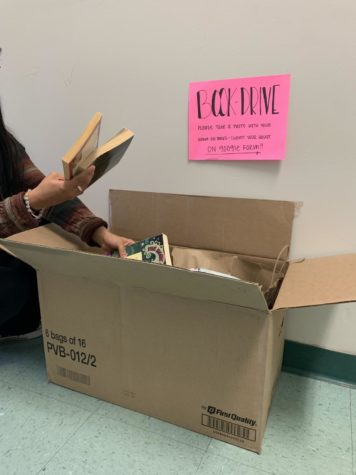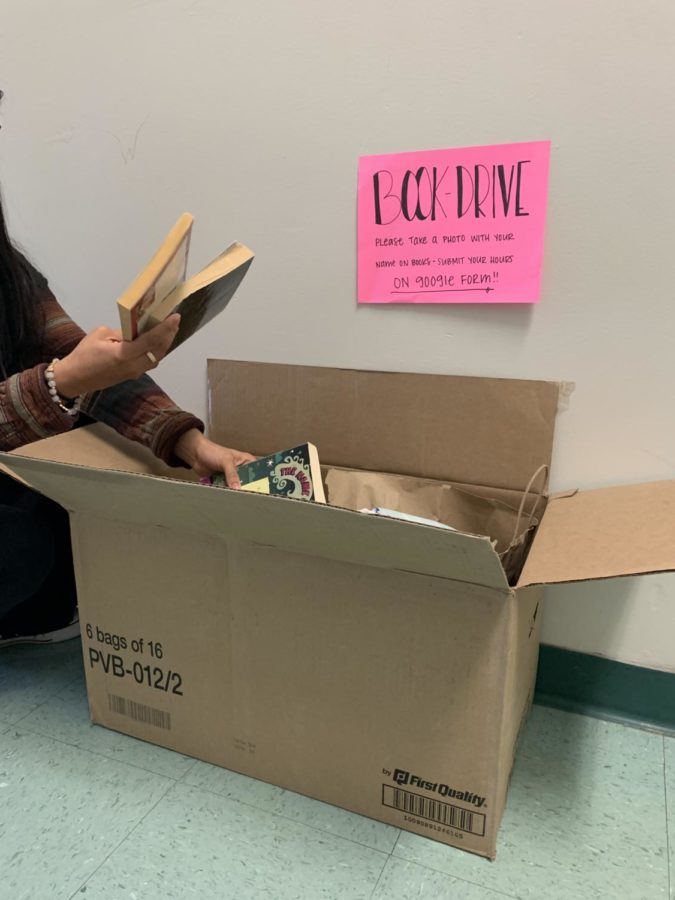Donating for service hours helps, hinders
May 10, 2023

Pro: food drives and donations provide ease, lessen stress
Key Club members can receive 30 minutes of service for each donated book, with a maximum of six book donations.
Volunteers buzz around a bustling community center organizing donations, finishing care packages and mailing out bundles of goods to those in need. However, despite their best efforts, they struggle to make ends meet due to the limited donations they receive.
Donations, no matter how small, make a positive impact on society by allowing students opportunities to give back to their community while fulfilling service hour requirements. With these vital donations, centers can not only achieve their goals, but can exceed them by making a large difference in the lives of those in need.
Although the Stanford Social Innovation Review states that giving time instead of money is more charitable, donating ultimately supports non-profit organizations. Additionally some believe that donations do not make a genuine impact in the community, but as long as the greater focus remains to make a positive impact on the community, donations are a flexible way to receive service hours.
Within CHS, the National Honor Society has held multiple food drives this year, giving students the opportunity to receive service hours in regards to the number of items they brought. The canned food drive, held in the beginning of December, had a sizable impact on society by addressing food insecurities within Fairfax County, with over 116 students of the 500 NHS members participating.
Students were able to help ensure families the access to nutritious meals in a group effort, as organizing an event of such a magnitude is difficult. Not only were students able to receive hours according to their meaningful contributions, but they were able to impact a growing problem within their community.
In addition to their food drives, the National Honor Society had offered a $5 money donation towards the cultural night that ethnic groups at CHS were hosting in March. However, their post was quickly revoked due to fairness disparities. Despite the donation elimination, money donations have the ability to directly impact a center as many service centers rely on funds to run. Most donation centers have existing volunteers to sort through and organize donations, but many still lack money and items as sponsors.
With the help of the money donation, the National Honor Society could have directly helped the school community and could have also provided students with more attainable service hours within their existing schedules.
Many students are engaged in time-consuming after school activities like sports, work, games and homework. Food drives and money donations cater to those that follow busy schedules by providing them convenient timings to donate. This flexibility is especially important for those who are engaged in multiple honor societies and groups that require many service hours.
While donations are an easier form of receiving service hours, as long as the greater focus is to make an impact in the community, they should remain for students. Denying students the opportunity to donate would make them less willing to participate in drives and donations in their future, causing long-term issues in the community. Offering donations as a form of completing service hours allows students to become educated with problems within their society and gives them an opportunity to make an immediate and long-standing impact.

Anjali is a senior in her fourth year with The Purple Tide. Outside of school, she is heavily involved in dance and often experiments with new styles to...
Con: donation service hours limit student effort, responsibility
Faced with the option of helping a teacher after school or donating a can of green beans, many students are inclined to choose the latter. However, both selections yield the same reward: one service hour.
According to Niche, completing 50 to 200 hours of service during high school is recommended for college. Prioritizing their prospects of post-secondary education, many students join numerous honor societies, clubs and extracurriculars in an effort to boost their resumes. As a result, required quotas for service hours skyrocket. With such a large student body, various student organizations have decided that a more convenient way to accommodate everyone is to offer service hours through donations and payments.
This year, CHS’s National Honor Society (NHS) has held two drives: one for food and one for winter clothing, both offering one service hour for each item contributed. Similarly, Key Club has held drives for stuffed animals and books while National Art Honor Society lets members donate art supplies as service hour opportunities.
In one of the most extreme examples of this phenomenon, on February 20, NHS stated that students would be able to receive one service hour by simply donating $5 toward Cultural Night. Out of the 20 slots available for this opportunity, 16 were filled almost immediately after the SignUpGenius link was posted. One day later, NHS revoked their decision, recommending that those interested in donating should consider volunteering during the event instead.
As seen from occurrences such as that and the numerous donation drives around the school, it’s clear that students take advantage of these “easy” service hour opportunities as much as possible. Many students even seek out numerous drives, attempting to donate the maximum amount at each one so they can knock their hour requirements out in a more efficient way.
This practice is advantageous only to those with the resources to participate. It’s easier for wealthier students to buy items to contribute, and subsequently, those who can consistently donate are able to complete their service hour requirements faster. Meanwhile, those who are from lower-income households or want to save their money have to acquire their service hours through actual activities, which can be much more time-consuming.
While donations do provide aid for those in need, they do not help students themselves—the inherent purpose of service hours is rendered null and void when students no longer have to work for their hours. Donating is philanthropy, not community service. It’s a much more passive than active process, since the only effort required is buying or finding items to give away.
According to Mayo Clinic Health System, volunteering is mentally beneficial, generating a sense of purpose and self-assurance. In addition, various acts of service offer new perspectives and experiences. Service learning also encourages the idea of civic responsibility and helps students explore possible career interests, according to FCPS.
Instead of just being able to contribute resources, having restrictions on what constitutes service learning would level the playing field, as more people would have to participate in legitimate volunteering opportunities.
Completing service hours should be about actually working with the community and learning through new experiences. It’s much more logical and rewarding knowing service hours were earned through hard work and determined effort. While donations from school drives are extremely beneficial for those in need, people should be philanthropic not with the intention of gaining service hours, but instead out of the goodness of their heart.

Haley Oeur is a senior in her third year with The Purple Tide. She loves walking into random clubs, and is part of the quiz bowl team, Reader's Club, Photo...

